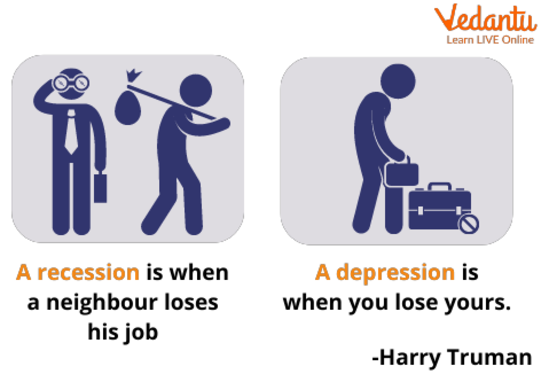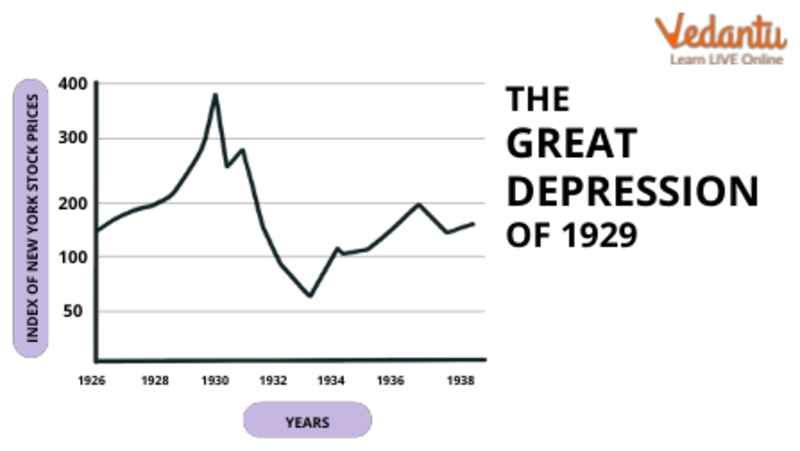




Introduction to Recession
Recession refers to a period of short-term economic decline during which trade and industrial activity are turned down, generally recognised by a fall in GDP in two successive quarters.
During a recession, the economy’s performance reduces for several months, distinguished by GDP contraction, higher unemployment rates and lower consumer spending. People may face a significant impact on their routine lives. Everything from clothes to groceries is often a very big budget, and the working class may face less job security.
(Image will be uploaded soon)
Recession
What Happens During a Recession?
Although there is no fixed sign of whether a recession is occurring or not, but the following can be considered some of the indicators of recession-
Income Instability: During the recession, people face income instability as employers retrench their workforce. Income inequality can also be proved as the wealthy are often less affected by the recession than the middle or lower classes.
Reduction in Production: As the cost of raw materials rises during the recession, businesses generally reduce their production activities, decreasing exports and overall economic activities.
Personal Consumption Expenditure: During a recession, the consumer's spending reduces as they have less money to spend, which lessens retail sales. Businesses may often lay off workers to reduce operational costs, and some may close due to fewer customers.
Unemployment: During the recession, the unemployment rate (the percentage of the total labour force that is unemployed but actively searching for work) inclines as corporations cut back on staff to lessen their expenditure.
Rise in Cost of Living: When inflation comes up with the recession, household essentials like groceries, wood and clothes are more costly than they used to be. Increases in prices make it difficult to make ends meet, so people often turn to strict budgets and cuts in discretionary spending.
Depression
Harry Truman gave a famous gag about the practical meaning of depression.
It’s a recession when your neighbour loses his job; it’s a depression when you lose your own.” ― Harry S. Truman.
Depression means an utmost recession that lasts three or more years or results in decline in the gross domestic product (GDP) of at least 10%. in a particular year. Depression is uncommon compared to mild recession and tends to come along with high unemployment and low inflation.

Recession and Depression
Features of Depression
A depression would involve:
Very high unemployment levels (In the great depression, the unemployment rate was up to 20 per cent or above)
Very low inflation.
A significant fall in consumer confidence.
Closing of businesses.
A significant fall in asset prices.
Liquidity trap.
Reduced trade and worldwide commerce.
Recession vs Depression
A recession is a global economic decline that continues for many months. Depression is a more acute downfall that continues for years. There has been only one depression in U.S. history: the Great Depression, which lasted a decade.
According to the National Bureau of Economic Analysis reports, the Great Depression was a fusion of 2 recessions. The first continued for 43 months, starting in August 1929 and ending in March 1933. The next continued for 13 months, from May 1937 to June 1938. The acute downturn lasted for about 10 years combined. There have been around 34 recessions since 1854. The recession has lasted for an average of ten months since 1945.
Gross domestic product (GDP) decreases in a recession for at least a few months. The GDP growth rate will slow for several quarters before it turns negative in a recession.
There is also a decline in 4 other critical economic indicators: employment, earnings, production, and retail sales. Reports on these come out monthly, so they usually signal a recession long before GDP turns negative.
A depression is prolonged and more disastrous than a recession. It has years of economic contraction. During the Great Depression, GDP was negative for 6 of 10 years. It contracted by a record of 12.9% in 1932. Unemployment touched around 25 per cent. Worldwide trade contracted by more than two-thirds, and prices fell more than 25 per cent.
The destruction of the depression was so much that the impacts of the Great Depression lasted for decades after it ended. Until 1954 the stock market didn't recover.
Case Study
The Great Depression of 1929- 1939
The Great Depression, which started in the U.S. in 1929 and spread internationally, was the longest and most acute economic downfall in modern history. It was marked by sharp declines in industrial manufactures and prices (deflation), mass joblessness, banking at the alarm, and fast increases in poverty rates and homeless people.

The Great Depression of 1929
Causes
Four factors played roles of varying importance-
The stock market crash of 1929 wore out confidence in the American economy, which resulted in a sharp decrease in spending and investment.
Banking at the alarm in the early 1930s caused many banks to fail, decreasing the amount of money available for loans.
The gold standard required foreign central banks to raise interest rates to prevent trade imbalances with the United States, distressing spending and investment in those countries.
The Smoot - Hawley tariff Act (1930) imposed steep tariffs on many industrial and agricultural products, inviting redressal measures that ultimately reduced output and caused global trade to shrink.
Summary
Recessions are repeated- they happen every few years after the economy reaches its top. Although it can be frightening if one hasn't experienced any before. One can dissipate most economic changes by taking steps like planning, decreasing and saving his/her spending.
Depression happens occasionally. It is the combined result of many recessions. A recession is indicated by a drop in employment, retail sales, manufacturing and income. A depression has effects on the economy that lasts for years.
FAQs on Recession and Depression
1. In situations of depression, where should one invest his money?
Depression means an utmost recession that lasts three or more years or results in a decline in the gross domestic product (GDP) of at least 10% in a particular year. Banking panics in a situation of depression. During the depression, many bank failures led people to take their money out of the bank, called a "run on the bank." Thankfully, one doesn't have to hide their money under a mattress or in a pit because of the Federal Deposit Insurance Corporation, which insures 100% of your savings. One’s money is safe in a bank as long as within FDIC guidelines.
2. Is the covid-19 pandemic leading to a second great depression?
Our lives would change drastically if the United States were to experience an economic downfall on the scale of the Great Depression. The ratio of unemployed and employed would be 1:4. The stock market would drop by 50%, which will take decades to recover.
The COVID-19 pandemic triggered a recession, but it's unlikely to cause depression. After the Great Depression of 1929, Central banks around the globe know how to prevent them from facing depression. They now make sure that banks have enough capital with them. They've lowered interest rates to zero. At the same time, the government has expanded many unemployment benefits.
3. Which has the long-term effect, recession or depression?
A recession is a period of short-term economic decline during which trade and industrial activity are turned down, generally recognised by a fall in GDP in two successive quarters. Depression lasts three or more years or results in decline in the gross domestic product (GDP) of at least 10%. in a particular year.
Recession usually lasts for months, whereas depression lasts for years and its impacts last for decades. Therefore, it is quite clear that depression has a long-term impact compared to recession.





















